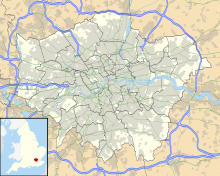National Army Museum

The main entrance of the National Army Museum from Royal Hospital Road
|
|
| Established | 1960 (collection); 1971 (building) |
|---|---|
| Location |
Royal Hospital Road London, SW3 United Kingdom |
| Coordinates | 51°29′10″N 0°09′36″W / 51.486111°N 0.16°W |
| Visitors | 215,721 (2008, up 7.3%) |
| Director | Janice Murray |
| Public transit access |
|
| Website | Official website |
The National Army Museum is the British Army's central museum. It is located in the Chelsea district of central London, adjacent to the Royal Hospital Chelsea, the home of the "Chelsea Pensioners". The museum is a non-departmental public body. The National Army Museum is usually open to the public every day of the year from 10.00am to 5.30pm, except on 24–26 December and 1 January, with free admission. However, from 1 May 2014 until spring 2017 it is closed to the public for a major Heritage Lottery Fund-funded rebuilding programme.
The collections of the National Army Museum relate the overall history of the British Army, British colonial, imperial and commonwealth forces and the British Indian Army as a whole from 1066 to the present and its effects on national and international history. However, prior to the 2014 closure, the Museum's displays on the period from 1066 to 1642 were wholly via interpretation rather than objects, since its collecting remit is from the English Civil War onwards. Though the National Army Museum does hold a small number of early objects (such as a bronze saker from the 1530s), acquisitions of pre-1642 military items for the national collection are usually made by the Royal Armouries. (Displays from 2016 onwards will be thematic rather than chronological.)
This remit for the overall history of British land forces contrasts with those of other military museums in the United Kingdom concentrating on the history of individual corps and regiments of the British Army. It also differs from the subject matter of the Imperial War Museum, another national museum in London, which has a wider remit of theme (war experiences of British civilians and military personnel from all three services) but a narrower remit of time (after 1914).
...
Wikipedia

